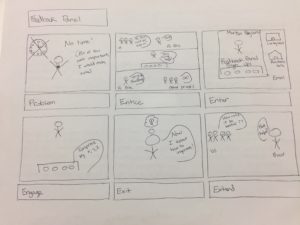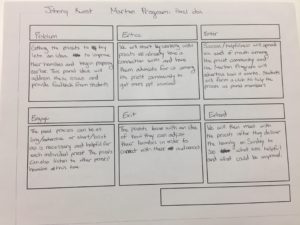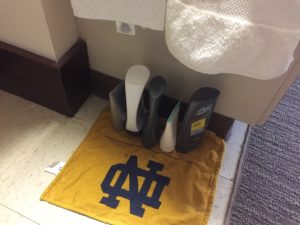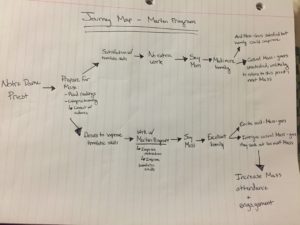

Author: John
Prototype Plan
1. Homily Helper Newsletter
What will you test?
This idea will consist of a newsletter email to be customized and sent out to the priests early in the week in order to begin preparing early for Sunday’s homily. The newsletter will contain a copy of The Observer, giving priests an idea of what sports teams are winning and what students on campus are talking about this week. Next, the newsletter will relay two different types of feedback from the priests’ previous homily; first, short responses to a question asking about the priest’s homily, as well as film of the priest giving the homily, so he can watch and pick up on things he may not be cognizant of while giving the homily. Lastly, the newsletter will give the Scriptures for Sunday’s Mass in order to aid preparation of the next homily.
Who, where, when, how?
The first aspect of this idea is collecting the feedback from students on the priests’ homilies. This data will be collected by our group designing a small, easy to use survey asking students to briefly discuss what they liked or didn’t like about the homily. After collecting this data, we will synthesize it and make it easy to read for the priests in the Homily Helper Newsletter. Next, we will work to film the homily of each priest we work with in order to give them the opportunity to watch film and recognize aspects of his preaching he may not be aware of while delivering the homily. This will be done either by the members of this group or someone else who will be at the given priest’s Mass who we will determine before the Mass starts. Lastly, we will add the Observer and the upcoming week’s readings, and compile all of this information on Sunday/Monday in order to distribute the Homily Helper Newsletter to the priests on Tuesday morning, giving them plenty of time to develop their homily throughout the week. This idea will be implemented the week after Easter, and then we will get together with the priests after the Sunday Mass to see if/to what extent the panel was helpful.
2. Feedback Panel
What will you test?
This idea will consist of priests giving their homilies to a panel of laypeople (undergraduates and/or MDiv students for example) before Sunday’s Mass, and receiving feedback and analysis on the delivery and content from the panel.
Who, where, when, how?
We plan on testing this idea in one location like a dorm chapel on campus where there the atmosphere of Mass is upheld and there is room for the priests to listen to one another if they choose to. We will choose the priests based on priests that we have interviewed and people they recommend would enjoy this idea. We will comprise the panel of students with different majors, geographic backgrounds, and genders.This will be done early in the week like on Tuesday, Wednesday, or Thursday evening, giving the priests ample time to react and make adjustments to their homilies based on the feedback from the panel. This idea will be implemented the week after Easter, and then we will get together with the priests after the Sunday Mass to see if/to what extent the panel was helpful.
3. “So you think you can preach?”
What will you test?
This idea would consist of a student competition in which students would be tasked to prepare and deliver their own homily based on the Scripture readings, and the priests will be judges of the competition. This idea would work in two ways: first, giving the priests a different perspective on the readings, showing them how their audience sees as the important takeaways from the readings; second, giving the students an understanding and appreciation of how difficult the process of preparing and delivering a homily.
Who, where, when, how?
We plan on testing this idea within the individual dorms, having each dorm (that we have members residing in) have their own competition with the priests in residence as the judges. This will be done early in the week like on Tuesday, Wednesday, or Thursday evening, giving the priests ample time to react and make adjustments to their homilies based on the students’ perspectives. This competition will be held the week after Easter, and then we will get together with the priests after the Sunday Mass to see if/to what extent this competition was helpful.
Ideation Summary
Idea 1: Homily Helper Newsletter.
This idea will consist of a newsletter email to be customized and sent out to the priests early in the week (Monday or Tuesday) in order to begin preparing early for Sunday’s homily. The newsletter will contain a copy of The Observer, giving priests an idea of what sports teams are winning and what students on campus are talking about this week. Next, the newsletter will relay two different types of feedback from the priests’ previous homily; first, short responses to a question asking about the priest’s homily, as well as film of the priest giving the homily, so he can watch and pick up on things he may not be cognizant of while giving the homily. Lastly, the newsletter will give the Scriptures for Sunday’s Mass in order to aid preparation of the next homily.
Entice: Priests would be enticed by given the opportunity to receive anonymous feedback of their homilies, for many priests that we interviewed said they would like to get more feedback. Furthermore, the priests would get all the information in one, succinct location for easy access to feedback and information on what students are pondering this week. The most difficult part of this step is enticing the students to give anonymous feedback, but because many students voiced that priests should improve their homilies and had opinions on how they could, it is clear that students have considered this idea and would be willing to help with short feedback surveys after Mass.
Enter: We would enter this idea by compiling the data from the feedback surveys as a team, filming the homilies during Mass, getting access to The Observer and Scripture readings online, and facilitating the newsletter to priests who want it.
Engage: Priests would engage with the newsletter throughout the week, seeing the information and praying/reflecting on the material. They would use the information to see how they could improve from the previous week, and bear that information and The Observer stories in mind when designing their next homily.
Exit: We would then speak with the priests after the Sunday Mass to see if/to what extent the Homily Helper Newsletter helped them prepare and deliver the homily.
Extend: Based on the priests’ feedback, we would then adjust the Newsletter according to their interests, customizing the Newsletters to each priest in order to be as helpful as possible.
Idea 2: Feedback panel
This idea will consist of priests giving their homilies to a panel of laypeople (undergraduates and/or MDiv students for example) before Sunday’s Mass (Thursday or Friday), and receiving feedback and analysis on the delivery and content from the panel.
Entice: The priests would be enticed because they would instant feedback and put themselves in a position for open dialogue with their audiences, which they often do not have. Furthermore, this idea would force the priests to prepare their homilies early in the week, for several priests expressed concern that they often do not get to prepare their homilies until Friday or even Saturday evening before Sunday’s Mass. Students could be enticed to participate in these panels by potentially creating a type of club on campus for students to help priests improve their homilies–Notre Dame students love to get involved and put more clubs on their resumes.
Enter: The priests would enter by designing their homilies and going to the set location (such as a dorm’s chapel on campus) and delivering the homily to the panel.
Engage: The priests would engage by delivering the homily and receiving feedback from the panel. The priest could then respond to the feedback and have an open dialogue with the panel. The priests could also choose to stay and listen to other priests’ homilies, potentially offering their own feedback to others.
Exit: Priests would receive this feedback and pray/reflect on it in preparation for how they can improve for Sunday’s Mass. We would then speak with the priests after Sunday’s Mass to see if/to what extent the Feedback Panel helped them prepare and deliver the homily.
Extend: Based on the priests’ feedback, we would then adjust the Panel according to what worked and what didn’t work, adjusting the panel to be as helpful as possible.
Idea 3: “So you think you can preach?”
This idea would consist of a student competition in which students would be tasked to prepare and deliver their own homily based on the Scripture readings, and the priests would be judges of the competition. This idea would work in two ways: first, giving the priests a different perspective on the readings, showing them how their audience sees as the important takeaways from the readings; second, giving the students an understanding and appreciation of how difficult the process of preparing and delivering a homily.
Entice: The priests would be enticed by the opportunity to hear the perspectives of students on the readings, which would be both fun/interesting to hear and could give the priests ideas for preparing their homilies. The students would be enticed because of their competitive nature, the unique opportunity to learn about the Mass in a new way and work on public speaking skills, and the incentive of a prize for the best homily (for instance, a Starbucks giftcard).
Enter: The students would enter by reading and preparing a homily to give to the panel of priests to judge on a Thursday or Friday in one of the dorms’ chapels. The priests would go about their week the same way, preparing their homily for Sunday as they usually would, leaving room for adjustments based on what they will hear from the competition.
Engage: The students will deliver their homilies to the priests, and the priests will judge them.
Exit: Priests would receive these ideas and pray/reflect on them in preparation for how they can improve for Sunday’s Mass to be more relatable to their audience. We would then speak with the priests after Sunday’s Mass to see if/to what extent the competition helped them prepare and deliver the homily.
Extend: Based on the priests’ feedback, we would then adjust the competition according to what worked and what didn’t work, adjusting the competition to be as helpful as possible.
Workarounds

The first workaround is clothes hanging on hooks meant to hang posters and other decorative items. The clothes are hanging there because there is not enough space for me to store all of my clothes in the small space allotted for clothing in the drawers and wardrobe given to each student.

The second workaround is a computer charge extending across the floor to the bed. Because the nearest outlet is at my desk, when I want to charge my laptop while using it on my bed, the charger has to stretch across the whole room, which presents a tripping problem.

The third workaround is my toiletries sitting on a towel handed out at one of the football games. Because there is no space to put my toiletries in my room, I put the toiletries on the towel to prevent getting my floor all wet after bringing the toiletries back after a shower.
Guiding Principles & Design Criteria
Design Goal
What have you learned about the target customers? What ends (functional, emotional, psychological, social) does the design need to fulfill for the target customer?
In this project, we have approached Catholic priests as target customers. For priests, we have learned that most of them (from our sample size at least) think that working to improve their own homiletic skills and the preaching ability of others is of utmost importance. They think that these improvements should start at the beginning of the priesthood, in the classes of the seminary with a stronger emphasis on the Scripture. Next, many of the priests expressed a desire to receive feedback on their homilies so that they may know what and how to improve in their preaching. They approached this aspect in a variety of ways, including a panel of laypeople to hear the homily early in the week and give feedback before the priest preaches on Sunday, filming the homilies and watching them to learn how to improve similar to an athlete watching game film, priest conferences on preaching, and several other ideas. Although these are all excellent ideas that can be helpful in the improvement of the homiletic skills of priests, a recurring theme among the priests we interviewed was lack of time. Due to the copious responsibilities of priests, it is difficult to find time to diligently work on preparing a homily, and many priests voiced that they spend much less time preparing to preach than they would like to “in a perfect world.” Therefore, an important aspect of this project is to understand and implement a system in which priests can work to improve their homilies, whether with one of the aforementioned options or with new ideas, while being cognizant of the time constraints that priests have.
User Perceptions
How important is your proposed offering to the target customer’s well-being? Are there aesthetic attributes necessary to succeed with the target customer? Are there reputational aspects involved? What are the key research insights?
The project of improving the homiletic skills is very important to most of the priests that we have interviewed. However, we are aware that this may not be representative of all priests, for our sample size consisted primarily of priests that we have good relationships with, and these priests are passionate about preaching and their audiences, making them good preachers. With that being said, there are absolutely reputational aspects involved in this project because although priests have a myriad of responsibilities, they are often only judged as a “good” priest by their preaching ability.
The key research insights we have discovered are that priests think there is a definite need to improve homiletic skills of themselves and other priests. Many priests believe that they are good preachers, even bad ones, but everyone could improve is some way or another. They think that this improvement needs to start at the beginning of the priesthood, the seminary, and continue throughout the life of a priest in some fashion. They want to connect with the people they are preaching to and bring them closer to God with their homilies. They want to find a way to improve while not taking away from their other responsibilities.
Problems/Needs/Opportunities
What are the target users’ preferred outcomes as they engage with the offering? What pain points does the target user experience with existing options? What gaps exist with existing options that may hamper the target user’s ability to achieve preferred outcomes? What are the newly emerging needs or aspirations of the target user?
Priests want to improve their homiletic skills of themselves and other priests in order to make the message of God clear to their audiences. The pain points in achieving this outcome are the constraints of time due to other obligations, priests not wanting to go out of their way to change their approach to preaching, and the lack of formal systems in place to improve the homiletic skills of priests. Existing options to improving homilies include “homily help” books and websites, but the gaps in these options are that they are not tailored to a certain audience, lose their effect over time, are not original thoughts or “inspired by the holy spirit touching me” (Fr. Kevin Russeau), are abundant and difficult to discern what is useful, and some priests do not desire to use these because they do not think they need to improve their current preparation tactics. The needs and aspirations of the target user are those which have already been stated: to implement a system (or systems) to improve the homiletic skills of priests while being mindful of the time constraints of priests.
Functional Attributes
Does the design of the offering need to accommodate specific use-case scenarios? List them in order of importance to the target customer. Does the design need to address compatibility or standards issues?
The design should provide priests with the ability to accommodate their own specific scenarios in which they are able to change their homily based on their audience, for preaching at a dorm Mass on campus, a wedding, or a funeral are very different scenarios that require different preparation techniques. Furthermore, the design of this program needs to provide valuable insights for priests of all ages, and prove to priests that may be hesitant to change their ideas about their process of preparing and delivering homilies that this process is worthwhile.
Constraints
What are the confines of our project work? What limitations might there be based on costs or requirements?
As previously stated, time is a major constraint in this project, for Catholic priests such as those who work at a university, college, or high school and parish priests have a plethora of responsibilities that require their attention, and preparing a homily can often take a backseat to other duties. Another constraint that is difficult to work around is the fact that priests have done things the same way for a long time, for there is currently no formal program of continued homiletic training after priests are ordained, so some priests may not be open to seeking out or accepting help in their homily preparation.
Guiding Principles
1. I’m fine, but these other guys definitely need help.
- There is a need to improve the homiletic skills of priests.
- Every priest could improve their preaching.
- Priests often see themselves as good preachers but recognize when others need to improve.
- According to our survey of students who attend Mass on campus, priests need to improve in three main ways:
- Relatability
- Shorter, more direct message
- Enthusiasm/excitement
“I think priests could improve their homilies in three main ways. First, I think priests try to do too much, they overreach and make things too complicated. Second, I think they often go too long. And three, they don’t make it relevant for real life. If you talk about saints or other things in the Church but do not connect it to life today, it’s not going to do any good with your audience.” -Fr. Sean McGraw C.S.C.
2. There are not enough hours in the day.
- Catholic priests have many other things to focus on (teachings, other sacraments, rector, campus ministry, chaplain, etc), but Protestant ministers primarily focus on preaching.
- The various other responsibilities of Catholic priests present major time constraints on priests.
- These time constraints lead priests to delay their homily preparation, until as late as the day before or morning of their Mass.

“In an ideal world, I would start preparing my homily on Monday or Tuesday by reading, reflecting, and praying on the readings and then pick up on different things in my life that relate to the readings throughout the week. However, because I have so many other things going on, the process often becomes truncated and I’ll read and reflect on the readings Saturday night for Sunday’s Mass.” -Fr. Pete McCormick C.S.C.
3. Hit me with your best shot.
- It is important for priests to receive feedback on their homilies in order to improve.
- There is currently no formal system for improving homiletic skills of priests after ordination.
- Because of this, many priests never receive any formal training for the rest of their lives.
- Laypeople often shy away from giving constructive criticism because they do not want to offend the priests or feel they are unqualified to give advice.
- Even when priests want feedback, laypeople are not in a position to give it.

“I feel that laypeople are not empowered in the Church. If I were in charge, I would install a “homiletics committee” of laypeople that would listen to the priest’s homily earlier in the week, like Thursday or Friday, and then give feedback and criticism of the preaching.” -Zack Imfeld MDiv.
Marten Program Journey Map / Stakeholder Map


Marten Program Design Brief
Project Description
The Marten Program in Homiletics and Liturgics may be able to improve the homiletic skills of Catholic priests by increasing motivation to give better, more connective homilies.
Intent / Scope
The initial scope of this project will focus on providing incentives to amplify motivation among Catholic priests to improve their homiletic skills. Over time, the intent of this project is to work towards solving the Catholic Church’s problem of dwindling attendance numbers at Mass by enhancing the homiletic skills of priests, for we hope that this improvement will lead to increased attendance in Mass, enlarged engagement in the sacraments, and widespread adherence to the teachings of the Church as professed in the homilies.
Exploration Questions
This project will inform key strategic questions including:
- How can the Marten program improve the homiletic skills of Catholic priests? How can the program work to provide incentives to motivate the priests to improve the homilies?
- How can the Marten program make Catholic Masses more appealing to the casual Mass-goer, increasing attendance in Sunday services?
- Are there other programs that the Marten program can learn from? If so, how can we incorporate successful attributes of these others programs into the Marten program and extend its outreach?
Target Users
The project will primarily focus on Catholic priests, but the indirect target audience will ultimately be the Catholics who are not avid Mass-goers, for we hope to increase attendance among this group by the enhanced homiletic and connecting abilities of the priests.
Research Plan
- Interview prominent Catholic priests (both at Notre Dame and elsewhere in the country), inquiring about their sources of motivation, tactics they learned in their studies of homiletics, and their opinions on how the problem could be addressed.
- Interview ministers outside of the Catholic Church about their opinions on how to motivate Catholic priests.
- Interview casual Mass-goers on what they look for in attending Mass, what aspects of the service sway their decision of whether they go or not, and what they wish they heard from priests in their homilies.
- Interview weekly (or daily) Mass-goers on what keeps them coming back to Mass and their opinions on how priests could improve their homilies.
Expected Outcomes
- Increased motivation and homiletic skills of the Catholic priests in the program.
- Increased enjoyment of preaching of the Catholic priests in the program.
- Increased attendance in Mass by casual Mass-goers, improving the community and individual faith lives of those impacted by the priests in the program.
Success Metrics
- Did we discover a compelling reason for Catholic priests to improve their homiletic skills?
- Did we unveil ways to motivate Catholic priests to improve their preaching abilities?
- Did we make the Mass more appealing to both avid Mass-goers and casual Mass-goers, increasing attendance in the latter?
Project Planning
A team made up of myself and the Notre Dame Design for America club will conduct the “exploration” and “research plan” phases over the course of a semester.
